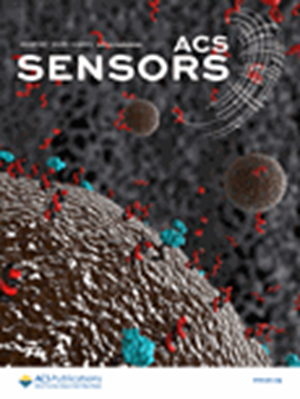A Highly Robust, Multifunctional, and Breathable Bicomponent Fibers Thermoelectric Fabric for Dual-Mode Sensing.
IF 8.2
1区 化学
Q1 CHEMISTRY, ANALYTICAL
引用次数: 0
Abstract
Wearable thermoelectric (TE) materials are seen as excellent candidates for flexible electronics because of their unique self-powered properties, multistimulus sensing and human waste heat conversion. However, currently reported flexible TE materials still face challenges such as poor durability, uncomfortable wearing and sensing signals crosstalking each other. Herein, this study describes a hot-air cross-linking method for the preparation of multifunctional TE fabrics with enhanced durability. Poly(ethylene terephthalate) (PET) fibers with core and sheath structures having different melting points were selected as flexible substrates. Poly(3,4-ethylenedioxythiophene)-poly(styrenesulfonate) (PEDOT:PSS) and single-walled carbon nanotubes (SWCNTs) were embedded stably on the surface of the sheath layer in the presence of heat treatment. The fiber-welded structure created by thermal cross-linking improves the durability of TE fabrics, including consistent mechanical and electrical properties after a 6 h wash test and 6000 compression cycles. The unique fiber structure of TE fabrics ensures excellent breathability (313.7 mm s-1 at 200 Pa), which meets the breathability requirements for human wear. In addition, the fiber-prepared sensors have excellent compressive strain response (20 ms response time and 30 ms recovery time) and precise temperature discrimination (0.17 K minimum discrimination temperature) for accurate real-time monitoring of the sensed signals. Thus, the TE fabrics can be used for human motion recognition, including pulse monitoring, sign language expression, and motions in joint areas. Moreover, the fabricated wearable TE device is connected to a Bluetooth module for wireless transmission, which can be used for mechanical and temperature sensing of the robot arm without signals crosstalking. This new durable TE fabric paves the way for the next generation of smart wearable technology.用于双模传感的高稳健性、多功能和透气性双组分纤维热电织物
可穿戴热电(TE)材料因其独特的自供电特性、多刺激传感和人体废热转换功能,被视为柔性电子器件的理想候选材料。然而,目前报道的柔性热电材料仍然面临着耐久性差、佩戴不舒适和传感信号相互串扰等挑战。本研究介绍了一种热空气交联法,用于制备耐久性更强的多功能 TE 织物。研究选择了具有不同熔点的芯和鞘结构的聚对苯二甲酸乙二醇酯(PET)纤维作为柔性基材。经热处理后,聚(3,4-亚乙二氧基噻吩)-聚(苯乙烯磺酸)(PEDOT:PSS)和单壁碳纳米管(SWCNT)被稳定地嵌入鞘层表面。热交联产生的纤维焊接结构提高了 TE 织物的耐用性,包括在 6 小时水洗测试和 6000 次压缩循环后仍能保持稳定的机械和电气性能。TE 织物独特的纤维结构确保了出色的透气性(200 Pa 时为 313.7 mm s-1),符合人体穿着的透气性要求。此外,纤维制备的传感器还具有出色的压缩应变响应(20 毫秒的响应时间和 30 毫秒的恢复时间)和精确的温度分辨能力(0.17 K 的最低分辨温度),可对感应信号进行准确的实时监测。因此,TE 织物可用于人体运动识别,包括脉搏监测、手语表达和关节部位的运动。此外,制成的可穿戴 TE 设备还与蓝牙模块连接进行无线传输,可用于机械臂的机械和温度传感,而不会产生信号串扰。这种新型耐用的 TE 织物为下一代智能可穿戴技术铺平了道路。
本文章由计算机程序翻译,如有差异,请以英文原文为准。
求助全文
约1分钟内获得全文
求助全文
来源期刊

ACS Sensors
Chemical Engineering-Bioengineering
CiteScore
14.50
自引率
3.40%
发文量
372
期刊介绍:
ACS Sensors is a peer-reviewed research journal that focuses on the dissemination of new and original knowledge in the field of sensor science, particularly those that selectively sense chemical or biological species or processes. The journal covers a broad range of topics, including but not limited to biosensors, chemical sensors, gas sensors, intracellular sensors, single molecule sensors, cell chips, and microfluidic devices. It aims to publish articles that address conceptual advances in sensing technology applicable to various types of analytes or application papers that report on the use of existing sensing concepts in new ways or for new analytes.
 求助内容:
求助内容: 应助结果提醒方式:
应助结果提醒方式:


